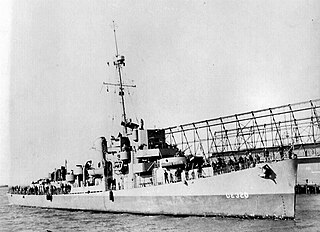
Admiral of the Fleet Sir Philip Louis Vian & Two Bars was a Royal Navy officer who served in both World Wars.

The British Mediterranean Fleet, also known as the Mediterranean Station, was a formation of the Royal Navy. The Fleet was one of the most prestigious commands in the navy for the majority of its history, defending the vital sea link between the United Kingdom and the majority of the British Empire in the Eastern Hemisphere. The first Commander-in-Chief for the Mediterranean Fleet was the appointment of General at Sea Robert Blake in September 1654. The Fleet was in existence until 1967.

Admiral of the Fleet John Cronyn Tovey, 1st Baron Tovey,, sometimes known as Jack Tovey, was a Royal Navy officer. During the First World War he commanded the destroyer HMS Onslow at the Battle of Jutland and then commanded the destroyer Ursa at the Second Battle of Heligoland Bight. During the Second World War he initially served as Second-in-Command of the Mediterranean Fleet in which role he commanded the Mediterranean Fleet's Light Forces. He then served as Commander-in-Chief of the Home Fleet and was responsible for orchestrating the pursuit and destruction of the Bismarck. After that he became Commander-in-Chief, The Nore with responsibility for controlling the east coast convoys and organising minesweeping operations.

The Commander-in-Chief, The Nore, was an operational commander of the Royal Navy. His subordinate units, establishments, and staff were sometimes informally known as the Nore Station or Nore Command. The Nore is a sandbank at the mouth of the Thames Estuary and River Medway.

USS Menges (DE-320) was an Edsall-class destroyer escort built for the United States Navy during World War II.
Admiral Sir Wilfrid John Wentworth Woods, was a Royal Navy officer who served in the Submarine Service in the Mediterranean.
Admiral Sir Geoffrey Nigel Oliver was a Royal Navy officer during the Second World War.

The Commander-in-Chief, Portsmouth, was a senior commander of the Royal Navy for hundreds of years. The commanders-in-chief were based at premises in High Street, Portsmouth from the 1790s until the end of Sir Thomas Williams's tenure, his successor, Sir Philip Durham, being the first to move into Admiralty House at the Royal Navy Dockyard, where subsequent holders of the office were based until 1969. Prior to World War I the officer holder was sometimes referred to in official dispatches as the Commander-in-Chief, Spithead.

The Eastern Fleet, later called the East Indies Fleet, was a fleet of the Royal Navy which existed between 1941 and 1952.

HMS Holcombe was a Type III Hunt-class destroyer of the Royal Navy. She was named after the Holcombe Hunt in Lancashire. She was the first and thus far only ship of the Royal Navy named HMS Holcombe.
Captain Harry Charles Birnie, was a Scottish sea captain and naval officer. His peacetime seafaring career was spent with the Cunard Line. He also served in the Royal Navy in both World Wars, being killed in action while in command of a merchant convoy in the North Atlantic in 1943.

HMS Algerine was the lead ship of her namesake class of minesweepers built for the Royal Navy during World War II, the Algerine-class minesweepers. Initially assigned to the North Sea, she was transferred to lead the 12th Minesweeping Flotilla. The Flotilla were posted to the Mediterranean to assist with Operation Torch. In 1942, after a successful mine clearing operation off Bougie, she was torpedoed by the Italian submarine Ascianghi, causing Algerine to sink, leaving only eight survivors.

Captain Frederick Stovin-Bradford was a Royal Navy officer and aviator in the Fleet Air Arm. During his career, Stovin-Bradford was involved in the sinking of the Italian submarine Iride, was one of the youngest officers to be promoted to the rank of captain since Nelson's time, and served as Staff Officer to the Flag Officer of Home Air Command in England and later Chief Staff Officer to the Flag Officer in charge of East Australia. His obituary in The Times described him as one of the most colourful personalities in the Fleet Air Arm.

The Rear-Admiral, Alexandria was an administrative shore based appointment of the British Royal Navy. The post was established during the Second World War, subordinate to the Commander-in-Chief, Mediterranean Fleet then later the Commander-in-Chief, Levant.

During the First World War, the Commander-in-Chief at the Cape, Rear Admiral Herbert King-Hall, expended much effort to destroy the elusive German light cruiser Königsberg.
Brighlingsea Naval Base was an installation of the British Royal Navy located at Brightlingsea, Essex, on the East Coast of England. It was a sub-area command under the Commander-in-Chief, The Nore from 1914 to 1921 and again from 1939 to 1945.

The Red Sea Station was a military formation of the Royal Navy. At various times it has also been referred to as Egypt Division and Red Sea and later the Red Sea and Canal Area. The Royal Navy had distinct formations for the Red Sea at intervals from 1846 until circa 1944-45.
The Rear-Admiral, Training Establishment Mediterranean was an command appointment of British Royal Navy established during World war II who supervised the training base HMS Canopus at Alexandria, Egypt He was subordinate to the Commander-in-Chief, Mediterranean Fleet.
The Senior British Naval Officer, Suez Canal Area was an administrative appointment of the Royal Navy established during World war II who was responsible for the naval base HMS Stag at Ismailia, Egypt. The SBNO was subordinate to the East Indies Station from 1939 to 1941 then the Mediterranean Fleet until 1942.










